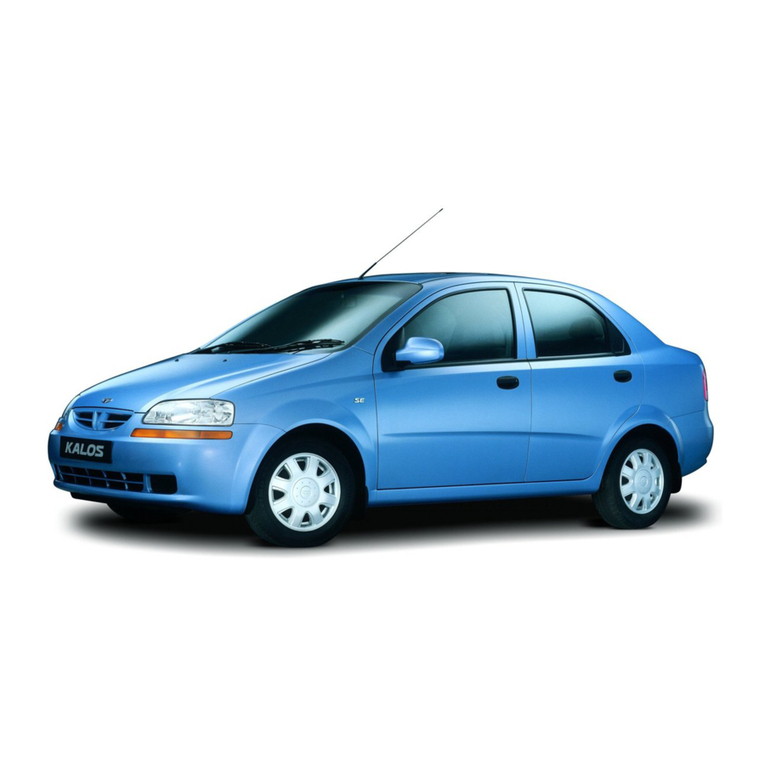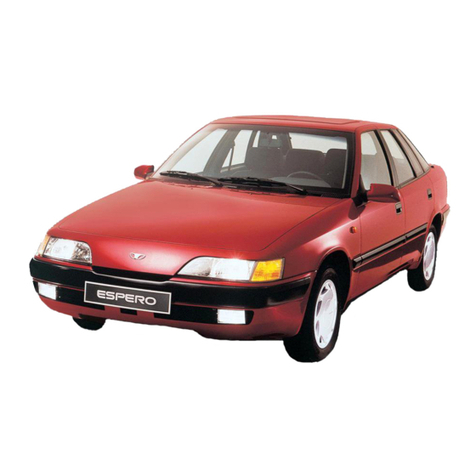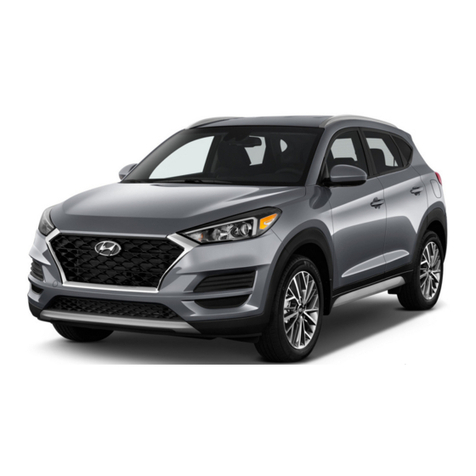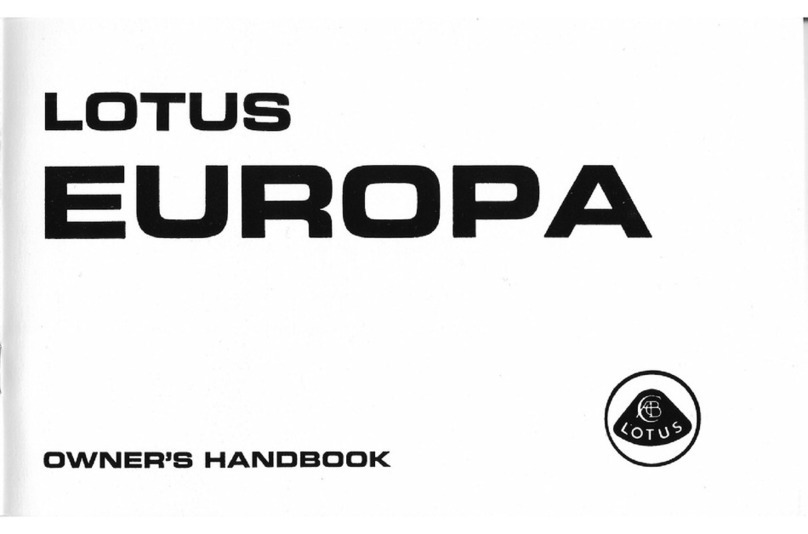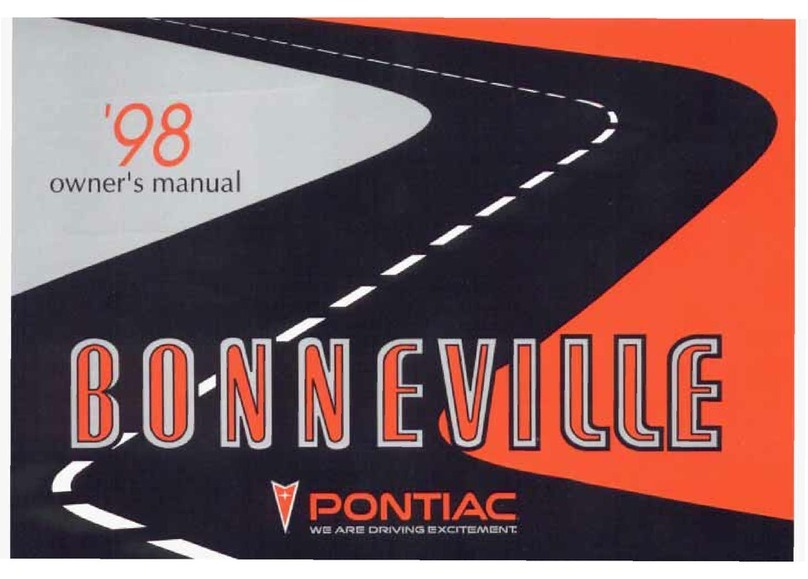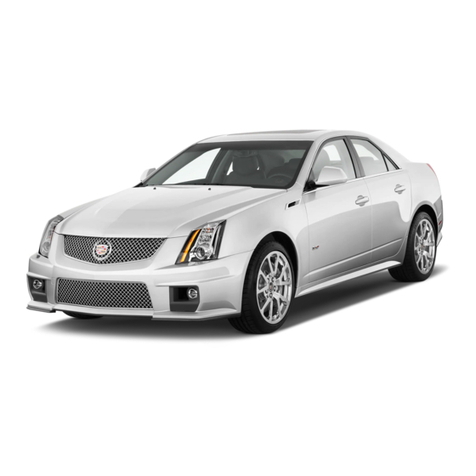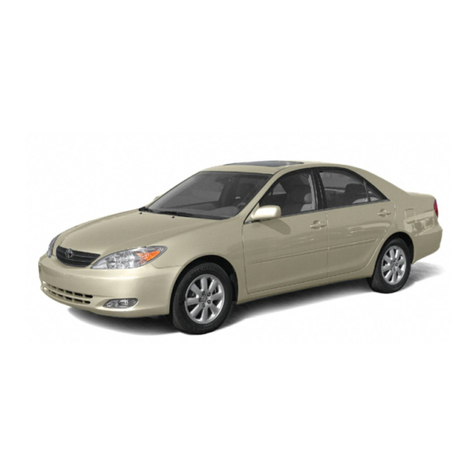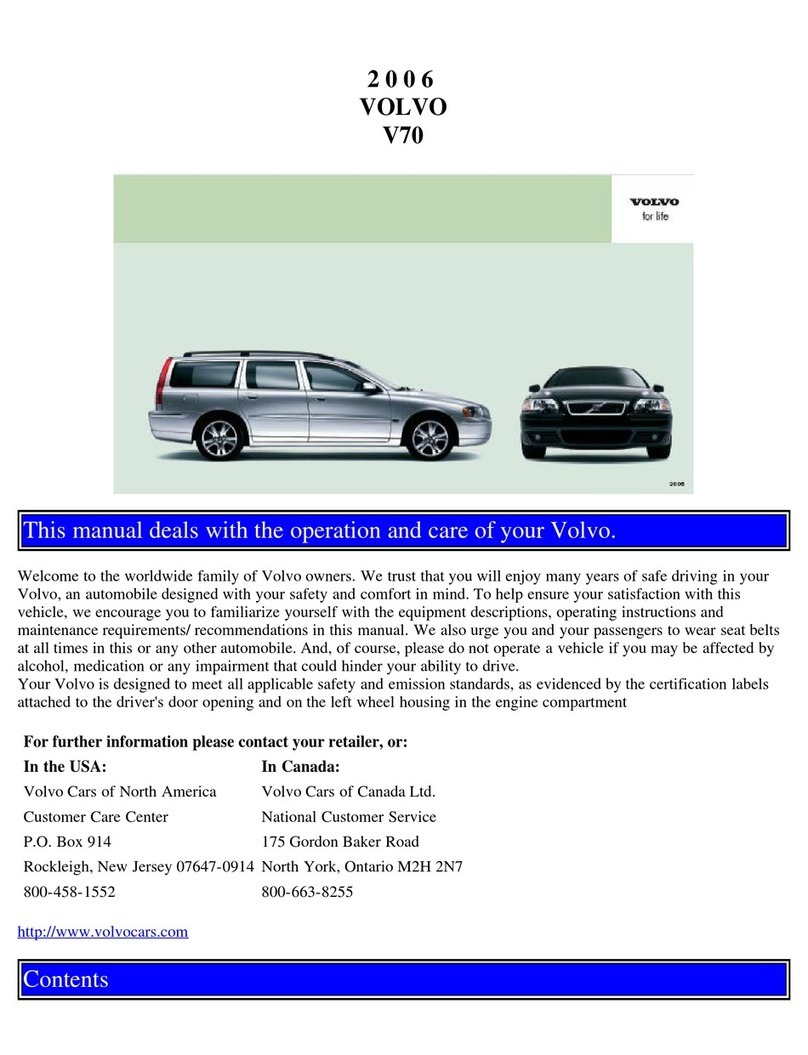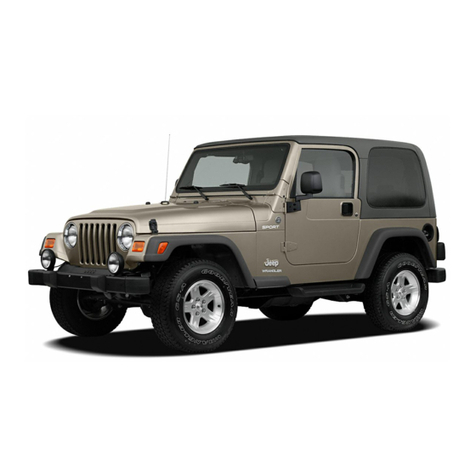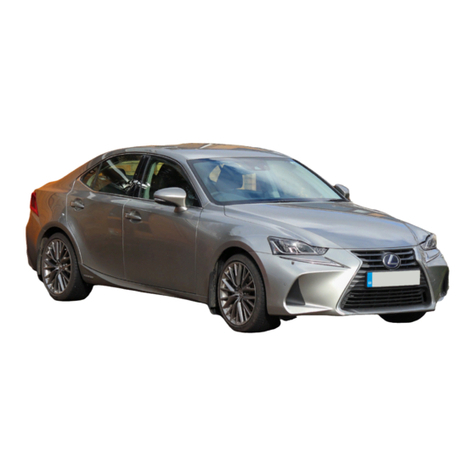Daewoo Cielo User manual

CIELO/NEXIA(LHD)
OWNER'S MANUAL
Untitled-53 10/31/2006, 12:51 PM1

Please read this manual an
instructions carefully.
To emphasize special informati
WARNING, CAUTION, and
special meanings.
Information following these s
should be carefully reviewed.
IMPORTANT NOT
The instructions must be o
order to reduce the risk o
injury. Please read these w
you don't, then you or other
hurt.
WARNING
These instructions point o
service procedures or preca
must be followed to avoid da
vehicle.
Your Daewoo car or other pr
be damaged if you don't fo
instructions.
CAUTION
Notes provide special inform
makes maintenance easier o
instruction clearer.
NOTE
This manual has been prepared to acquaint you with the operation and maintenance
of your new DAEWOO and to provide important safety information. We urge you to
read it carefully and follow the recommendations to help assure the most enjoyable,
safe and trouble-free operation of your vehicle.
When it comes to service, remember that your DAEWOO dealer knows your vehicle
best and is interested in your complete satisfaction.
We would like to take this opportunity to thank you for choosing a DAEWOO product
and assure you of our continuing interest in your motoring pleasure and satisfaction.
This manual should be considered as a permanent part of your vehicle, and must remain
with the vehicle at the time of resale.
DAEWOO MOTOR CO., LTD.
INCHON, KOREA
FOREWORD
Untitled-53 10/31/2006, 12:51 PM2

Please read this manual and follow its
instructions carefully.
To emphasize special information, the words
WARNING, CAUTION, and NOTE have
special meanings.
Information following these signal words
should be carefully reviewed.
IMPORTANT NOTICE
We would like to point out that non-Daewoo
Genuine parts and accessories have not
been examined and approved by Daewoo,
and in spite of continuous market product
monitoring, we cannot certify the suitability
nor the safety of such products whether
they are installed or intended for fitment in
our vehicles. Daewoo is not liable for any
damage caused by the use of non-Daewoo
Genuine parts and accessories.
The instructions must be observed in
order to reduce the risk of personal
injury. Please read these warnings; if
you don't, then you or others could be
hurt.
WARNING
These instructions point out special
service procedures or precautions that
must be followed to avoid damaging the
vehicle.
Your Daewoo car or other property can
be damaged if you don't follow these
instructions.
CAUTION
Notes provide special information which
makes maintenance easier or important
instruction clearer.
NOTE
All informations, illustrations and
specifications in this manual are based on
the latest product informations available at
the time of publication.
Daewoo reserves the right to change
specifications or design at any time without
notice and without incurring any obligation
whatsoever.
This vehicle may not comply with the
standards or regulations of other countries.
Before attempting to register this vehicle in
any other country, check all applicable
regulations and make any necessary
modifications.
This manual describes options and trim
levels available at the time of printing, and
therefore, some of the items covered may
not apply to your vehicle. If any doubt exists
about any of the options or trim levels,
please do not hesitate to contact your
Daewoo dealer for information on the latest
specifications.
*This asterisk in this manual signifies
that an item of equipemt is not included
in all vehicles (model variants, engine
options, models specific to one country,
optional equipment, etc.)
Untitled-53 10/31/2006, 12:51 PM3

1. BEFORE DRIVING YOUR CAR ........................................................................................................................... 1ñ1
2. STARTING AND OPERATING .............................................................................................................................. 2ñ1
3. INSTRUMENT AND CONTROLS ......................................................................................................................... 3ñ1
4. OTHER CONTROLS AND FEATURES ................................................................................................................ 4ñ1
5. VENTILATION, HEATING AND AIR CONDITIONING* .......................................................................... 5ñ1
6. AUDIO SYSTEM* ................................................................................................................................................. 6ñ1
7. IN CASE OF EMERGENCY ................................................................................................................................. 7ñ1
8. SERVICE AND MAINTENANCE .......................................................................................................................... 8ñ1
9. VEHICLE CARE .................................................................................................................................................... 9ñ1
10. SPECIFICATION AND SERVICE DATA ............................................................................................................. 10ñ1
TABLE OF CONTENTS
Untitled-53 10/31/2006, 12:51 PM4

1ñ1
BEFORE DRIVING YOUR CAR

1ñ2
Following a few simple precautions for the
first few hundred kilometers can add to
the future performance, economy and long
life of your car.
ï Do not race the engine.
ï Drive at varying speeds, trying not to
"strain" the engine.
ï Avoid hard stops, except in
emergencies.
This will allow the brakes to bed in
properly.
ï Avoid full-throttle starts.
BEFORE ENTERING THE CAR
BEFORE DRIVING OFFBREAK-IN PERIOD
ï Adjust your seating position.
ï Adjust inside and outside mirrors.
ï Ensure that all occupants of the car
have fastened their seat belts.
ï Check the operation of the warning
lights when key is turned to "II" position.
ï Check all gauges.
ï Release the parking brake and ensure
that the brake warning light goes out.
ï Be sure you understand your car and
its equipment and how to operate it
safely.
ï Ensure that windows, outside rearview
mirrors and lights are clean, undamaged
and unobstructed.
ï Visually note inflation condition of tires.
ï Check that all lights are working.
ï Check that the area is clear if you are
about to reverse.
ï Check under the vehicle for leaks.
It is the owner's responsibility to
frequently check all lights, signaling
systems and warning indicator lights. It
is important that any malfunction is
corrected promptly to ensure the safety
of you, your passenger and other
drivers.
WARNING

1ñ3
Front doors can be locked or unlocked from
outside by using the key.
To unlock, turn the key towards the rear of
the car. All doors can be locked or unlocked
from the inside by pushing down or pulling
up the door lock button located on the
window sill on each door.
KEY
Two keys are provided which fit all key
cylinders.
Keep one of the two keys as a spare.
DOOR LOCKS
All doors, except the driver's, can be locked
from the outside by pushing down the door
lock button then closing the door.
The lock button on the driver's door cannot
be pushed down when the door is open,
thus preventing the driver from being
inadvertently locked out.
However, if the door handle is raised, the
lock button on the driver's door can be
pushed down when the door is open.
If you wish to lock the driver's door without
using the key, set the button in the lock
position before closing the door. The outside
door handle must be held up while the
driver's door is being closed.
unlock
lock
unlocklock
Be careful not to lock your keys in the
vehicle.
CAUTION
Key number plate
The key number is stamped on the key
number plate. For vehicle security, keep the
key number plate in a safe place, not in the
vehicle. You should also record the key
number in a safe place, not in the vehicle.
This deters unauthorized persons from
obtaining a duplicate key.
Before leaving the vehicle, remove the
ignition key.
WARNING

1ñ4
ï To open the door from the inside,
1. Pull the door lock button up,
2. Pull the door catch.
By pressing down or pulling up the interior
lock button on the driver's door or by
turning the key as far as it will go, all doors
are locked or unlocked.
SYSTEM
*
CENTRAL DOOR LOCKING
Always remove the ignition key and
lock all doors when leaving your
vehicle unattended.
NOTE
CHILD SAFETY DOOR LOCKS
When the metal latch beneath the lock on
either of the rear doors is pushed upwards,
the door cannot be opened from the inside.
Rear doors locked with the child safety
mechanism can still be opened from the
outside provided that the door lock button
is not pushed down.
latch
pull
lock
unlock
upwards

1ñ5
To raise or lower the door window, rotate
the window regulator handle in the door
panel.
DOOR WINDOWS*
3 door model
The front windows can be operated by two
rocker switches on the center console
when the ignition switch is placed in
position "II".
Driver's
side switch
Passenger's
side switch
To open, pull catch and push window
glass outwards to the open position.
When closing, fold catch back to lock.
REAR QUARTER WINDOWS
*POWER WINDOW SWITCHES*

1ñ6
4 and 5 door models
The windows can be operated by switches
located in the driver's door armrest when
the ignition switch is in position "II".
Passenger's door window switches are
located in the armrest of each door. Push
the switch down to lower the window and
push the switch up to raise the window.
Release the switch when the window
reaches the desired position.
When the safety lock switch is pressed, the
passenger's windows cannot be operated
except by the driver.
Care must be taken when operating the
power windows. There is a risk of injury,
particularly for children, and a danger
that articles could become trapped.
Make sure that all vehicle occupants
know how to operate the windows
correctly.
If there are children on the rear seat,
press the safety lock button to isolate
the individual window switches.
Keep a close watch on the windows
when closing them. Ensure that nothing
becomes trapped in them.
Upon leaving the vehicle the driver
must remove the ignition key in order
to prevent other vehicle occupants from
operating the windows (with a potential
risk of injury).
Do not extend any portion of your body
out of the opening at any time.
WARNING
When the safety lock switch is depressed,
power is cut to the individual door window
switches. However, the driver can still
operate all the windows using the switches
in the driver's door armrest.
Safety lock switch
Passenger's
side switch
Driver's side
switch
Rear right
side switch
Rear left
side switch

1ñ7
The inside mirror can be adjusted up, down
or sideways to obtain the best view.
The inside mirror has day and night
positions.
Move the knob to the night position to
reduce glare from the headlights of vehicles
behind you.
INSIDE REARVIEW MIRROR
TILTABLE STEERING WHEEL
*
The steering wheel can be adjusted in four
different positions.
This steering wheel can be adjusted by
pulling with the left hand the control lever
on the side of the steering column, moving
the wheel to the desired position and then
releasing the lever. In order to provide easy
access to the vehicle, the wheel should be
moved to its uppermost position when
leaving the car.
pull
Do not put large objects on the flat area
behind the rear seat, as they may
obscure vision and could become
dangerous projectiles in the event of a
sudden stop or collisions.
WARNING
night
day
adjusting knob
Always adjust the mirror with the
selector set to the day position.
Only use the night position if it is
necessary to reduce glare from the
headlights of vehicles behind you.
Be aware that in this position you may
not be able to see some objects that
could be seen in the day position.
CAUTION
Do not adjust the tiltable steering
wheel while the vehicle is moving to
avoid losing control of the vehicle.
CAUTION

1ñ8
FRONT SEAT SLIDE ADJUSTMENT
To move the seat forwards or backwards,
pull up the control lever located inboard and
under the front of the seat and hold it.
Then, slide the seat to the desired position
and release the lever.
OUTSIDE REARVIEW MIRROR
Adjust the outside rearview mirrors with
the adjusting levers so that you can see
not only each side of the road behind you
but also each side of your vehicle. This
helps you determine the location of objects
seen in the mirror.
Simply move the adjusting lever in the
desired direction to adjust the position of the
mirror.
ïFoldable mirror*
The outside rearview mirrors can be folded
flat against the side of the vehicle by
pushing it backward when driving in narrow
road or washing the vehicle, etc.
ïBreak-away mirror*
The outside mirrors will be released from
their supports under heavy impact for the
safety of passengers and pedestrians. The
mirrors can be locked back into position with
a light blow of the hand at light angles to
the vehicle.
ïConvex mirror*
The outside mirror on the passenger's side
is convex if it says "OBJECTS IN MIRROR
ARE CLOSER THAN THEY APPEAR".
Use this mirror to get a wider view of the
road behind.
adjusting
lever
ï Take care when judging the size or
distance of a vehicle or other object
seen in the side convex mirror. Be
aware that objects will look smaller
and appear farther away than when
viewed in a flat mirror.
ï Use your inside rearview mirror to
determine the size and distance of
objects seen in the side convex
mirror.
ï Do not scrape ice off the mirror
face; This may damage the surface
of the glass. If ice should restrict
movement of the mirror, do not
force the mirror adjust it.
ï To remove ice, use a deicer (spray
or blower, for example), sponge or
soft cloth.
ï Be sure to adjust mirror angles
before driving.
CAUTION
Do not adjust the driver's seat while
the vehicle is moving to avoid losing
control of the vehicle.
After adjustment, rock the seat back
and forth to be sure it is securely
locked.
Make sure that the driver's seat is
properly adjusted before you start
driving.
WARNING
pull

1ñ9
DRIVER'S SEAT HEIGHT
The desired seat height can be achieved by
turning the crank handle located below the
driver's seat.
ADJUSTMENT
*
To adjust the seat back, lift up the lever (or
rotate the recliner) until the desired angle is
achieved.
ADJUSTMENT
FRONT SEAT RECLINING
The seat backs should always be in a
fairly upright position when driving, or
the effectiveness of the seat belts may
be reduced.
The seat belts are designed to offer
maximum protection when seat backs
are in the fully upright position.
Make sure that the reclining seat backs
are properly adjusted before you start
driving.
WARNING
To avoid excessive seat belt slack,
which reduces the effectiveness of
seat belts, make sure that the seats
are adjusted before the seat belts are
fastened.
WARNING
Do not place articles under the front
seat that may interfere with the seat
lock mechanism. Loose objects might
interfere with seat-slide mechanism.
CAUTION
lift up
turn

1ñ10
TILTING BACK OF FRONT
3 door vehicles only:
For access to the rear seat area, pull up
the release lever to fold the front seat
forward.
SEATS
*
REAR SEAT ARMREST
*
4 door vehicles:
The pull-down rear seat armrest is located
in the center of rear seat.
HEAD RESTRAINTS
Head restraints are designed to help reduce
the risk of neck injuries.
To raise the head restraint, pull it up. To
lower it, press the lock release button on
the left side of head restraint at the seat and
push the head restraint down.
To remove the head restraint, pull it up as
far as it will go while pushing the lock
release.
To adjust the front seat head restraint, pull
it up or push it down.
To remove the head restraint, pull it up as
far as it will go while pushing the lock
release button on the left side of head
restraint at the seat.
To adjust or remove the head restraint*of
the rear seat, push the lock release lever
on the right side of head restraint rearward
and slide it up or down.
<sedan models>
<hatchback models>
Adjust the top of the head restraint so
that it is closest to the top of your ears.
After adjusting the head restraint,
make sure it is locked in position.
Do not drive with the head restraint
removed.
CAUTION
lift-up
Incorporated in the armrest is an opening
for the ski sleeve, for carrying long/thin
loads.
press
rear
seat push
front
seat
turn

1ñ11
ï Make sure that each seat belt
buckle is inserted into the proper
buckle catch. It is possible to cross
the buckle in the rear seat.
ï Do not wear your seat belt over
hard or breakable objects in your
pockets or on your clothing. If an
accident occurs, objects such as
glasses, pens, etc. under the seat
belt can cause injury.
ï Never wear the shoulder belt under
your arm nearest door. Make sure
that the shoulder portion of seat belt
is positioned midway over the
shoulderñnever across the neck.
ï Be sure the lap belt is fitted snugly
around the hips, not the waist.
ï Never use a belt for more than one
person at a time.
ï Never allow a child stand up or
kneel on the seat.
ï Never allow a child to be held in
somebody's arms while the vehicle
is moving.
ï Never let the belt system become
damaged by a door or seat.
WARNING
ï To help reduce the risk of personal
injury in collisions or sudden
maneuvers, use the safety belts
following these instructions on their
proper use, maintenance, and use
with child restraint systems.
ï Children small enough for child
restraints (as indicated on the label
of such restraints) should always be
transported in them. Accident
statistics indicate children are safer
when properly restrained in the rear
seat rather than in the front seat.
Accordingly, a child restraint
system should be placed in the rear
seat.
ï Children who have outgrown child
restraint systems should sit in the
rear seat and be restrained with the
seat belt. If child's seating position
has a shoulder belt which is on or
very close to the face or neck,
move the child close to the center
of the vehicle, slightly inboard of the
shoulder belt, or move the child to
a position without a shoulder belt if
possible.
WARNING
SEAT BELT PRECAUTIONS
To protect you and your passengers in the
event of an accident, it is recommended that
the seat belts be worn by all occupants
whilst the vehicle is in use. Seat belts should
be worn correctly.
Rear passengers not wearing seat belts are
a danger to the driver and front passenger
in the event of an accident.
The seat belts are designed to be used by
only one person at a time: they are not
suitable for use by children below 6 years
of age. Suitable child seats/booster
cushions should be fitted.
It is recommended that pregnant
women should wear a lap-shoulder
belt properly if at all possible. This will
reduce the likelihood of injury to both
the woman and the unborn child. The
lap belts should be worn as low as
possible throughout the pregnancy.
WARNING
If the belt locks when being pulled out,
rewind it completely in the retractor,
then pull it out to the desired length.
NOTE

1ñ12
Each Daewoo vehicle is equipped with three
point seat belts with automatic retractors,
allowing freedom of body movement when
driving at even, constant speeds, although
the spring-tensioned belts are always a
snug fit.
This type of belt requires no length
adjustment. Once worn, the belt adjusts
itself to the movement of wearer, but in the
event of a sudden or strong shock, the belt
automatically locks to restrain the wearer's
body.
THREE POINT SEAT BELT
WARNING
ï Seat belts should be adjusted as
firmly as possible, consistent with
comfort, to provide the protection
for which they have been designed.
A slack belt will greatly reduce the
protection afforded to the wearer.
ï Care should be taken to avoid
contamination of the webbing with
polishes, oils and chemicals, and
particularly battery acid. Cleaning
may safely be carried out using
mild soap and water. The belt
should be replaced if webbing
becomes frayed, contaminated or
damaged.
ï Periodically inspect seat belt
assemblies for excessive wear and
damage. It is essential to replace
the entire seat belt assembly after
it has been worn in a severe
impact, even if damage to the
assembly is not obvious.
ï Never wear the belts with straps
twisted or with a buckle release
button facing downward or inward.
ï Do not put anything into the opening
where the safety belt passes
through the trim panel. This may
jam the retractor or damage the
belt.
ï The seat belt will provide
maximum protection for its wearer
if the recliner seat back is placed
in fully upright position. When the
seat back is reclined, there is
greater risk that the passenger will
slide under the belt, especially in
a forward impact accident, and
may be injured by the belt or by
striking the instrument panel or
seat backs.
ï No modifications or additions
should be made by the user which
will either prevent the seat belt
adjusting devices from operating to
remove slack, or prevent the seat
belt assembly from being adjusted
to remove slack.
WARNING

1ñ13
SEAT BELT HEIGHT ADJUSTOR
*
On seat belts with a height-adjustable upper
anchorage point: pull belt out, depress the
area indicated by an arrow and adjust the
height.
This is particularly important if a smaller
person has previously selected a lower
position.
Too high a position can impair comfort.
USING THE BELT
Pull the belt evenly out of the retractor and
guide it across the body, making certain that
it is not twisted.
Insert the metal latch plate cinto the
buckle d.
To remove the belt, depress the red push-
button on the buckle. The belt will retract
automatically.
If the belt locks when being pulled out,
rewind it completely in the retractor,
then pull it out to the desired length.
NOTE
Both arms should not be under or over
the shoulder belt. Rather, one should
be over and the other under.
Do not wear the shoulder portion of
seat belt under the arm. Make sure
that the shoulder portion of seat belt
is positioned midway over the
shoulderñnever across the neck, and
the lap portion of the belt is fitted
snugly around the hips, not the waist.
WARNING
Always be sure that the belt is
positioned across the shoulder, as
close to your neck as possible and not
on your upper arm or neck. Failure to
do so could reduce the amount of
protection in an accident and increase
the chance of injury.
CAUTION
press
press

1ñ14
LAP BELT
A lap belt is installed in the center of the
rear seat.
Insert the tongue into the buckle until it
locks.
To lengthen, hold the tongue at right angles
to the belt and pull on the belt. To shorten,
pull the free end of the belt away from the
tongue, then pull the belt clip to take up the
slack.
CARE OF BELTS
Always keep the seat belts clean and dry.
Clean only with a mild soap solution or
lukewarm water.
Do not bleach or dye belts since this may
severely weaken them. Make sure that the
belt is not damaged or trapped by sharp
edged objects.
Periodically inspect all parts of the belts and
have damaged parts replaced. A belt which
has been overstretched in an accident must
be replaced by a new one.
Do not perform any alterations to your
vehicle's belt system.
All seat belt assemblies, including
retractors and attaching harness,
should be inspected after any
collision. We recommend that all seat
belt assemblies in use during a
collision be replaced unless the
collision was minor and the seat belts
show no damage and continue to
operate properly. Seat belt
assemblies not in use during a
collision should also be inspected and
replaced if damage or improper
operation is noted.
WARNING
The seat belt warning chime will sound for
about 4 to 8 seconds when the ignition
switch is placed in the "II" position unless
the driver's seat belt is securely fastened.
SEAT BELT WARNING CHIME
Position the lap belt low on the hips.
To remove the belt, depress the red button
on the buckle.
Never wear the lap belt across your
abdomen. During accidents it can
press sharply against abdomen and
increase the risk of injury.
Be sure that the lap belt is fitted
snugly around the hips, not on the
waist.
CAUTION
INSERT to fasten
PRESS to unfasten
PULL to
lengthen
Belt clip
PULL
PULL

1ñ15
Child restraint installation
Your vehicle has been designed to
accommodate a child restraint on the rear
seat. When using a child restraint, read the
Installation Instructions supplied with the
child restraint and follow the directions for
fitment carefully.
When installing the child restraint, use the
correct anchor bolt. (5/16" bolt)
The anchor bolt must be engaged at least
5 full threads in the anchorage.
If you have any queries regarding the
installation of a child restraint, consult a
Daewoo Dealer.
Anchorage locations
Child restraint anchor fittings have been
installed to coincide with the three rear
seating positions as follows.
CHILD RESTRAINT
Sedan Models:
Anchorages are located at either side and
center of the shelf behind the rear seat.
They are covered with the shelf carpet and
the anchor fitting nuts are welded beneath
the shelf.
Hatchback Models:
Anchorages are located at either side and
center of the lower rear tail member.
ï Infants and small children should
never be transported unless they
are properly restrained. Restraint
systems for infants and small
children should be used. Make sure
that the system you purchase
meets applicable safety standards.
Read and follow all the directions
provided by the manufacturer.
ï A child restraint system should be
placed in the vehicle's rear seat.
ï When the child restraint system is
not in use, remove it or fasten it with
a safety belt so that it will not be
thrown forward in the case of a
sudden stop or accident.
Under all circumstances the anchor
bolt must be engaged at least 5 full
threads in the anchorage.
ï Children could be endangered in a
crash if their child restraints are not
properly secured in the vehicle.
(Continued)
WARNING

1ñ16
DRIVER'S AIR BAG
*
The air bag is stored in the center pad of
the steering wheel.
The air bag Supplementary Restraint
System (SRS) helps protect the driver's
head and chest against injuries in the event
of a collision.
The air bag system activates during severe
collisions which are either frontal or when
the impact angle is up to 30∞from straight
ahead.
The air bag inflates within milliseconds
during a crash and forms a safety cushion
for the driver.
After the air bag completely inflates, it
immediately deflates so that it does not
interfere with the driver's visibility or ability
to steer and operate other controls.
The air bag inflates with considerable force
and speed. It is therefore important that the
driver's seat and seat back should be
correctly adjusted, for the air bag to be fully
effective. The driver's seat should be
adjusted so that the steering wheel can be
reached with the arms slightly angled.
When the air bag inflates, an operating
noise may be heard and a small amount of
smoke-like gas will be released. The gas is
harmless and does not indicate that there
is a fire.
ï Child restraint anchorages are
designed to withstand only those
loads imposed by correctly fitted
child restraints. Under no
circumstances are they to be used
for adult seat belts, harnesses or for
attaching other items or equipment
to the vehicle.
ï If child restraint anchor bolt is
removed from the shelf, the hole
must be effectively sealed with
another suitable bolt to prevent
exhaust gases entering the vehicle
interior.
WARNING
30∞
30∞
This manual suits for next models
1
Table of contents
Other Daewoo Automobile manuals

Daewoo
Daewoo MUSSO User manual
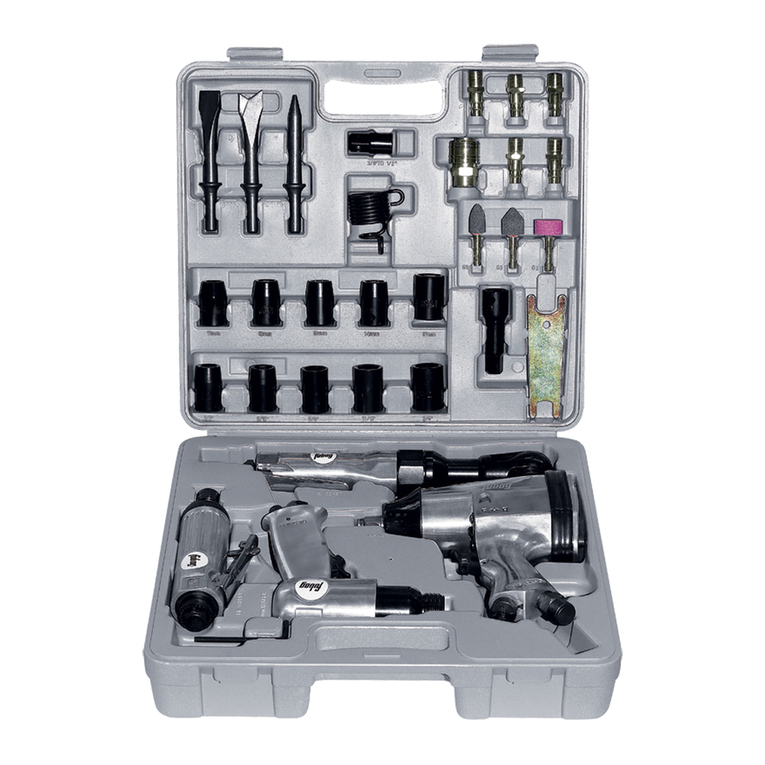
Daewoo
Daewoo MATIZ User manual
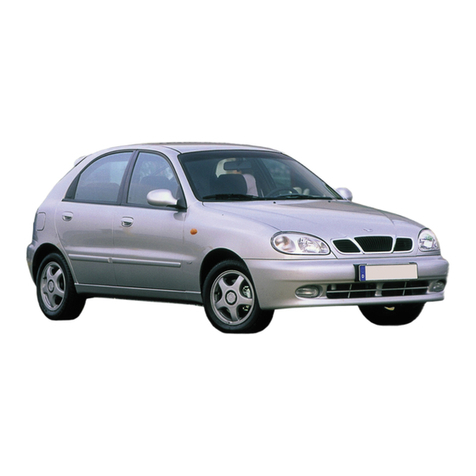
Daewoo
Daewoo NUBIRA User manual

Daewoo
Daewoo MUSSO User manual
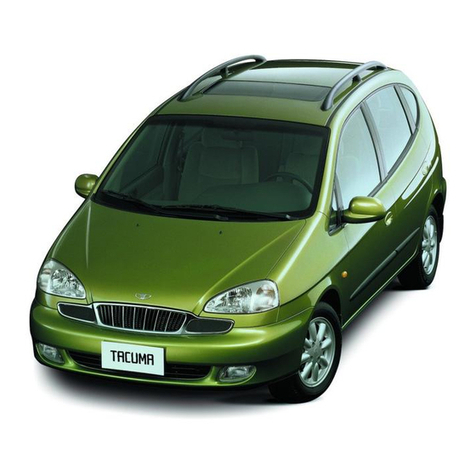
Daewoo
Daewoo TACUMA Operating instructions
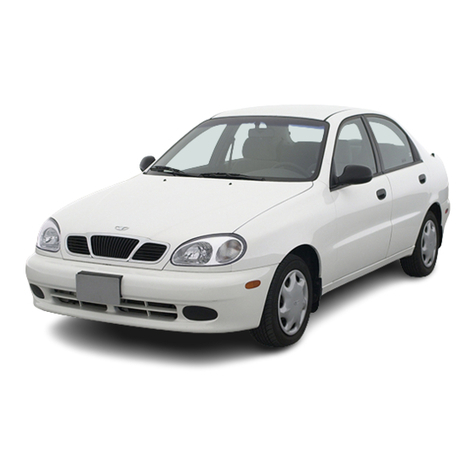
Daewoo
Daewoo Lanos 2002 User manual
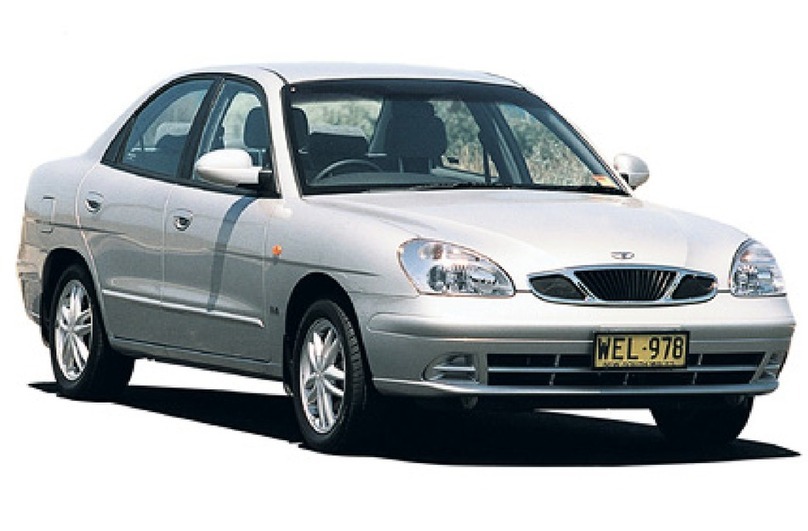
Daewoo
Daewoo NUBIRA User manual

Daewoo
Daewoo RACER 1998 Quick start guide

Daewoo
Daewoo KORANDO User manual

Daewoo
Daewoo NUBIRA User manual
Popular Automobile manuals by other brands

Wheego
Wheego LiFe 2011 owner's manual
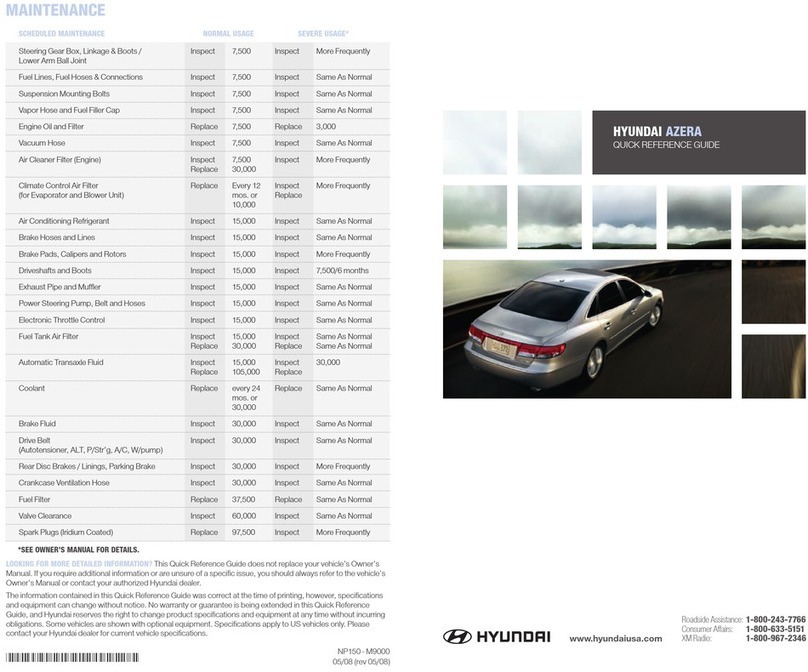
Hyundai
Hyundai 2013 Azera Quick reference guide

Ferrari
Ferrari 550 maranello owner's manual

Mitsubishi MOTORS
Mitsubishi MOTORS Outlander 2018 owner's manual
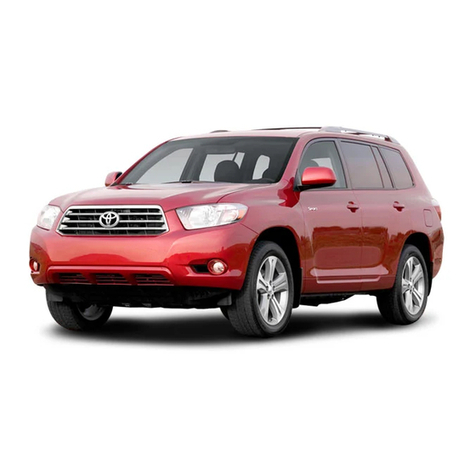
Toyota
Toyota Highlander GVU48 Series Dismantling manual

Mercedes-Benz
Mercedes-Benz 2007 E -Class Wagon Operator's manual


